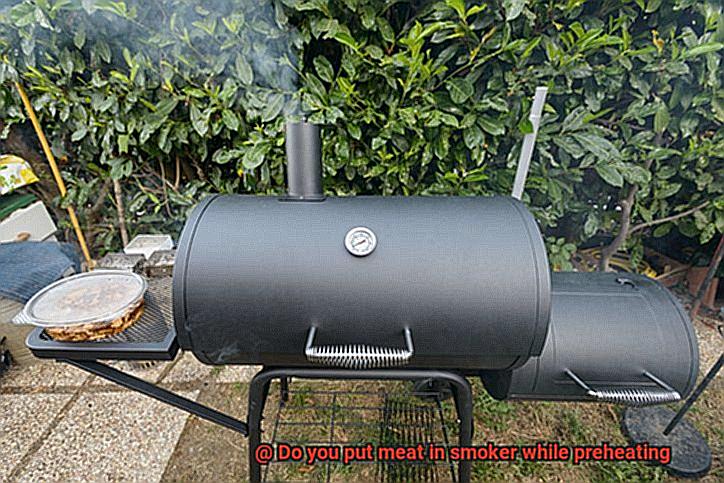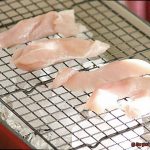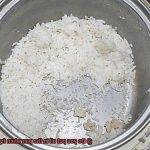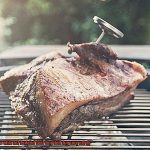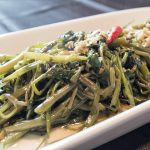Welcome to the smoky world of meat smoking, where flavors dance and aromas sing. If you’re new to this delicious technique, you might be wondering, “Should I put my meat in the smoker while it’s preheating?” Well, fret not, because today we’re going to explore the ins and outs of smoking meat to ensure your taste buds are in for a treat.
First things first, preheating your smoker is key to maintaining a steady temperature during the cooking process. But when it comes to adding your precious cuts of meat, the general rule is to wait until the smoker reaches the desired heat. This can take anywhere from 20 minutes to an hour, depending on your equipment and recipe.
While your smoker heats up, take some time to prepare your meat. Whether it’s marinating, seasoning, or injecting those flavors deep into its juicy core, use this opportunity wisely. Once that magic temperature is reached inside your smoker – ta-da. – it’s showtime for your meat.
Remember, preheating ensures stability and consistency in temperature control throughout the smoking journey. By waiting until that sweet spot is reached, you give yourself the best chance at achieving beautifully smoked and flavor-packed results.
Now that we’ve covered the basics, let’s dive deeper into mastering the art of smoking meat. From nailing temperature control and selecting the perfect wood to understanding cooking times like a pro – get ready to become a true maestro of the smoker.
Contents
What Is Preheating?
Imagine a sizzling hot grill, wisps of smoke rising from the surface, and the delectable aroma of perfectly cooked meat. How can you achieve such culinary perfection? It all starts with one crucial step – preheating. In this blog post, we will delve into the importance of preheating when it comes to grilling and how it can elevate your cooking game to new heights.
Even Heat Distribution:
Preheating your grill is essential for achieving even heat distribution. By allowing your grill to reach and stabilize at the desired cooking temperature, you ensure that every inch of your meat receives equal amounts of heat. Say goodbye to overcooking one side while the other remains underdone.
Sanitizing and Cleaning:
Preheating has an added benefit – it cleans and sanitizes your grill. As the grill heats up, any leftover residue or moisture from previous cookings is burned off, providing a hygienic cooking environment for your meats. Bid farewell to unwanted flavors and welcome a clean slate for culinary creations.
Infusing Smoky Goodness:
The distinct smoky flavor is one of the most delightful aspects of grilling. Preheating allows your grill to build up a layer of smoke before placing the meat on the grates. This imparts a deep, smoky flavor profile that elevates your meats to gourmet levels.
Factors Affecting Preheating Times:
Keep in mind that different grills have varying preheating times. Electric smokers require less preheating time compared to charcoal or wood pellet smokers. Additionally, outdoor temperature and weather conditions can also impact preheating times. Patience is key, as the perfect grilling experience is worth the wait.
Conclusion:
Preheating may seem like a small step, but it plays a vital role in achieving succulent, flavorful meats. By allowing your grill to reach the desired cooking temperature, evenly distributing heat, sanitizing the surface, and infusing that mouthwatering smoky goodness, you set the stage for grilling greatness.
Why Is Preheating Important?
Unlocking the secrets of preheating can take your grilling skills to a whole new level. But why is preheating so important? Let’s dive into the reasons why this step is crucial for achieving mouthwatering results.
First and foremost, preheating creates a stable cooking environment. When you preheat your smoker or grill, every nook and cranny is evenly heated, eliminating those pesky cold spots that can ruin a perfectly cooked piece of meat. Imagine sinking your teeth into a burger that’s uniformly cooked from edge to edge. With a properly preheated cooking surface, this culinary dream becomes a reality.
But there’s more to preheating than just even cooking. It also helps burn off any leftover gunk from previous cookouts. You know that unappetizing taste when you bite into a burger and catch a hint of last week’s barbecue? By preheating your grill, any lingering grease or food particles are incinerated, leaving you with a clean and sanitary cooking surface. Say goodbye to unwanted flavors and hello to a fresh start every time you fire up the grill.
Texture and tenderness are two vital elements in the world of grilling, and preheating plays a significant role in achieving them. When you preheat your grill, it gives your meat a head start on the cooking process. The initial burst of heat sears the surface, trapping in all those juicy flavors that make your taste buds dance with delight. Picture sinking your fork into a tender steak or biting into a succulent chicken breast that practically melts in your mouth. Preheating sets the stage for these culinary wonders.
But wait, there’s even more. Preheating your grill is not just about taste; it’s about time and efficiency too. Who wants to spend ages waiting for their food to cook? By preheating your grill, you slash both the grill and meat’s heating time. This means quicker cooking times and less fuel consumption. It’s a win-win situation where you get to indulge in your favorite grilled dishes without wasting precious time or resources.
What Happens If You Put Meat in a Smoker While Preheating?
Imagine the sizzle of meat hitting a hot grill, the intoxicating aroma of smoke wafting through the air, and the anticipation of sinking your teeth into a perfectly cooked piece of meat. But before you dive into that culinary delight, there’s one crucial step that demands your attention – preheating. The act of preheating your smoker sets the stage for barbecue perfection. So, let’s explore what happens if you throw meat into a smoker while it’s still preheating.
Uneven Cooking:
Preheating your smoker ensures that it reaches and maintains the desired temperature for cooking. Placing meat in a smoker before it has properly preheated can lead to uneven cooking. As heat gradually spreads throughout the smoker, the temperature may not be consistent, resulting in some parts of the meat being overcooked while others remain underdone. Say goodbye to that juicy, evenly cooked masterpiece.
Lackluster Crust or Bark:
The tantalizing crust or bark that forms on smoked meat is what elevates it from ordinary to extraordinary. Preheating allows your smoker to generate smoke and heat, paving the way for that irresistible outer layer. However, if you rush and introduce your meat too soon, you’re denying yourself that savory goodness. The result? A lackluster crust that fails to deliver on flavor and texture.
Extended Cooking Time:
Time is of the essence, especially when you have hungry guests eagerly waiting for their BBQ fix. By placing cold meat into a hot smoker during preheating, you unintentionally lower the overall temperature inside.
This means longer cooking times as the smoker struggles to regain its optimal heat levels. As hours pass by, mouths water, stomachs growl, and patience wears thin.
Safety Concerns:
While indulging in smoky delights, safety should never be compromised. Food safety guidelines stress the importance of rapidly heating foods to safe internal temperatures to prevent bacterial growth. Placing meat in a preheating smoker increases the risk of not reaching these safe temperatures quickly enough. This can potentially put your loved ones’ health at risk and transform your backyard feast into a recipe for disaster.
What Are the Benefits of Waiting Until the Desired Temperature is Reached Before Adding the Meat?
Imagine the sizzling sound of meat hitting a hot grill on a sunny summer afternoon, the tantalizing aroma of smoke wafting through the air. But before you rush to throw that meat onto the grates, hold your horses.
Preheating your grill to the desired temperature is a crucial step that can make or break your culinary masterpiece. In this article, we will explore the undeniable benefits of waiting until the desired temperature is reached before adding meat to the grill. Get ready to take your grilling game to new heights with a touch of patience.
Even Cooking:
You know that disappointing feeling when one end of your steak is perfectly cooked, while the other end remains underdone? By waiting for your grill to reach the desired temperature, you ensure even heat distribution throughout the cooking surface. This means no more unevenly cooked meats—just perfectly tender and juicy results from edge to edge.
Proper Smoke Infusion:
The secret behind mouthwatering grilled meats lies in the tantalizing flavors created by wood smoke. Waiting until the grill has reached the ideal temperature allows for proper smoke infusion into your meat.
This ensures that the wood chips or charcoal produce clean and flavorful smoke, enhancing the taste profile of your grilled delights. Say goodbye to bitter or acrid aftertastes and hello to a symphony of smoky goodness.
Reduced Cooking Time:
We’ve all experienced those moments of hunger-induced impatience while waiting for our meat to cook. Preheating your grill before adding the meat can help reduce overall cooking time. The heat from a preheated grill penetrates cold meat more efficiently, cooking it through faster without sacrificing tenderness and succulence. So you can satisfy your cravings in less time without compromising on quality.
Food Safety:
Safety should always be a top priority when it comes to grilling. Preheating your grill not only ensures even cooking but also helps eliminate any harmful bacteria that may be lurking on the grates. By waiting for the desired temperature, you create an environment that minimizes bacterial growth during cooking, reducing the risk of foodborne illnesses. Keep your loved ones safe while indulging in the flavors of the grill.
Consistent Results:
Every grill has its unique personality, and getting to know its quirks can help you achieve consistent results with your cooking. Waiting until the desired temperature is reached allows you to familiarize yourself with your grill’s heat distribution and adjust your cooking techniques accordingly. This knowledge empowers you to consistently achieve the perfect doneness and flavor in your grilled meats, impressing family and friends with every cookout.
How to Properly Preheat a Smoker
Imagine a warm summer evening, the tantalizing aroma of barbecue wafting through the air, and a plate of perfectly grilled meats waiting to be devoured. Achieving that mouthwatering result starts with one crucial step – properly preheating your smoker. In this comprehensive guide, we will walk you through the essential steps to ensure your smoker is ready to deliver smoky, flavorful goodness every time.
Step 1: Cleanliness is Key
Before embarking on the preheating process, take a moment to ensure your smoker is a clean canvas ready to create culinary masterpieces. Remove any ash or debris from previous cooks and give those grates a good scrub. A clean smoker means no unwanted flavors or contamination during the preheating process. It’s like starting with a blank canvas – pure and ready for your artistic touch.
Step 2: Fueling Your Fire
Choosing the right fuel for your smoker is akin to selecting the perfect paintbrush for an artist. Whether it’s charcoal, wood chips, pellets, or a combination, pick your preferred fuel source and load it up. This choice will depend on personal preference and the type of smoker you’re using. Each fuel type adds its unique flavor profile to the final masterpiece.
Step 3: Ignite Your Passion
The fire dances to life as you carefully light it up using a chimney starter or an electric starter. Say no to lighter fluid, as we want to avoid any unwanted chemical tastes on our food. Allow the flames to work their magic until the coals are fully ignited and covered in white ash. It’s like coaxing a flame from a spark – patience and precision are key.
Step 4: Venturing into Temperature Control
Controlling the airflow is like conducting a symphony – it sets the stage for perfect cooking temperatures. Adjust the vents on your smoker to allow just the right amount of oxygen in. Opening them lets the heat soar, while closing them tames it down. Balancing these adjustments will help you maintain that desired temperature throughout your cooking journey. It’s like orchestrating a perfect harmony – finding the balance between heat and air.
Step 5: Let the Preheating Begin
Close the lid and let the anticipation build as your smoker preheats to perfection. The waiting time will depend on your smoker type and desired temperature. As a general rule of thumb, it takes about 20-30 minutes for a smoker to reach its optimal cooking temperature. Patience is a virtue here, my friends. This waiting period is where the magic happens – flavors meld, temperatures stabilize, and the stage is set for greatness.
Different Types of Smokers and Their Preheating Processes
Are you a grill enthusiast looking to try your hand at smoking meat? Well, you’re in luck. There are various types of smokers available on the market, each with their own unique preheating processes. In this article, we’ll explore the different types of smokers and how to properly preheat them for mouth-watering results.
Offset Smokers:
Offset smokers consist of a firebox that is separate from the cooking chamber. To preheat an offset smoker, start a fire in the firebox and let it burn until it reaches the desired temperature. The heat from the firebox then travels into the cooking chamber, creating a smoky environment for your meat to cook in. Once preheated, you can add your meat to the cooking chamber and get ready for some delicious smoky flavors.
Vertical Water Smokers:
Vertical water smokers have a water pan that acts as a heat sink between the heat source and the cooking grates. To preheat this type of smoker, fill the water pan with water and start a fire in the bottom. The heat from the fire will then transfer to the water, creating steam and maintaining a consistent temperature inside the smoker. Once it reaches the desired temperature, you can add your meat to the cooking grates and let the magic happen.
Electric Smokers:
If you prefer a hassle-free experience, electric smokers are perfect for you. Simply plug it in, set the desired temperature using the built-in thermostat, and wait for it to reach that temperature before adding your meat. These smokers are easy to use and maintain a steady temperature throughout the cooking process, ensuring perfectly cooked meat every time.
Pellet Smokers:
Pellet smokers use wood pellets as fuel and have digital controls for temperature regulation. To preheat a pellet smoker, fill the hopper with pellets made from compressed wood and set the desired temperature on the digital control panel. The hopper automatically feeds the pellets into a firebox, where they are ignited and produce smoke and heat. Wait for the smoker to reach the desired temperature before adding your meat and let the pellets work their magic.
Kamado-Style Smokers:
Kamado-style smokers are made from ceramic or insulating materials and have vents for airflow control. These smokers are known for their excellent heat retention properties and versatility. To preheat this type of smoker, start a fire in the bottom using charcoal or wood chunks, and adjust the vents until you reach the desired temperature. The ceramic material retains heat well, allowing for even cooking temperatures. Once preheated, it’s time to add your meat and enjoy the smoky goodness.
Remember, each type of smoker has its own unique preheating process, so it’s essential to follow the manufacturer’s instructions. Preheating your smoker ensures consistent and even cooking temperatures, resulting in perfectly cooked and delicious meat.
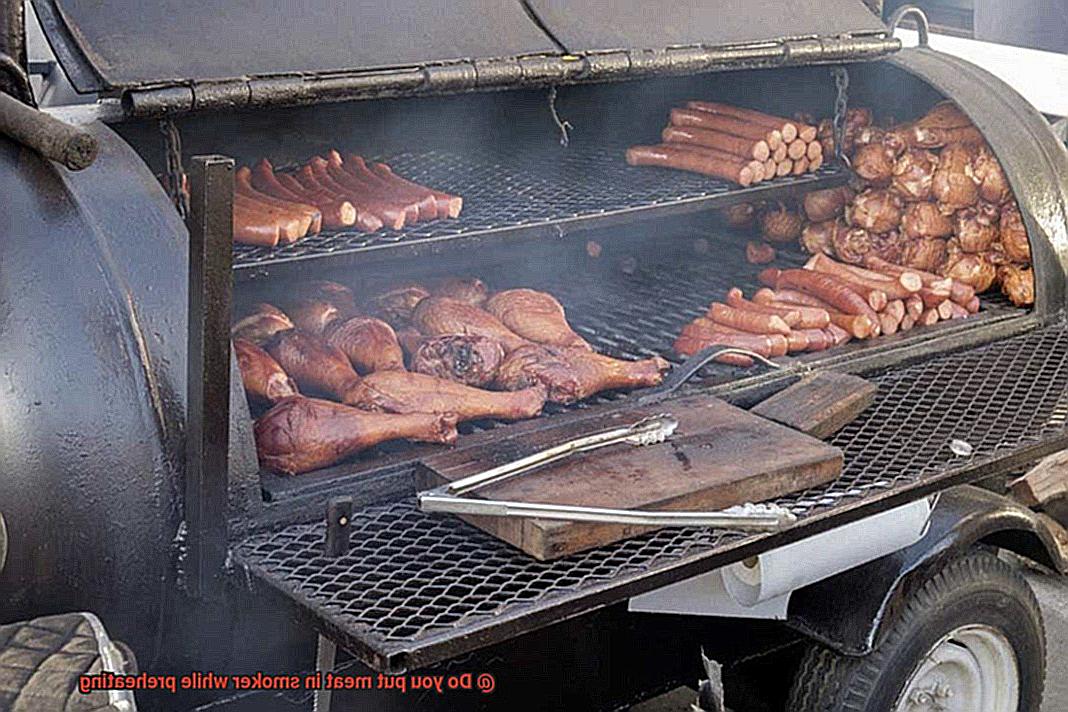
Tips for Better Grilling Results
Grilling is not just about cooking food; it’s an art form that requires skill and practice. With these tips, you’ll be able to achieve better grilling results and impress your friends and family with your delicious creations. Let’s dive in and discover the secrets to becoming a grill master.
Start with Clean Grates:
Before you even think about firing up the grill, take a few moments to clean the grates thoroughly. Just like an artist needs a clean canvas, you need a clean surface to work your grilling magic. Scrub away any leftover residue or debris that could affect the flavor of your food. Trust me, starting with clean grates sets the foundation for mouthwatering results.
Preheat Your Grill:
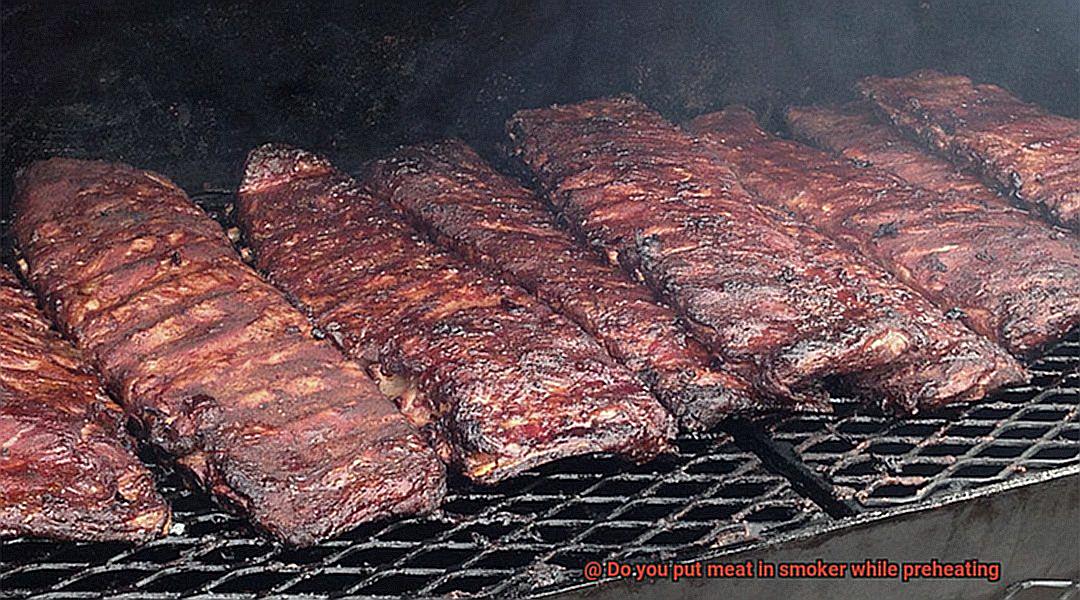
Think of preheating as your warm-up routine before hitting the dance floor. Preheating your grill is essential for achieving better grilling results. It helps to sear the meat quickly, locks in the juices, and gives you those beautiful grill marks that make your food look Instagram-worthy. So be patient, preheat your grill for at least 10-15 minutes before placing your meat on it.
Oil the Grates:
Just like putting on sunscreen protects your skin from getting burned, oiling the grates protects your meat from sticking. Lightly oil the grates before placing the meat on top using a brush or a folded paper towel dipped in oil. This not only prevents sticking but also helps in achieving those perfect grill marks that will make your guests drool.
Use the Right Temperature:
Every piece of meat has its own rhythm, just like every song has its own beat. It’s crucial to use the right temperature when grilling different meats to ensure they are cooked to perfection. Invest in a good meat thermometer and familiarize yourself with the appropriate temperatures for the meats you’re grilling. This will help you avoid undercooking or overcooking your food and guarantee juicy, succulent results.
Don’t Overcrowd the Grill:
Picture trying to fit all your friends in a tiny car – it’s just not going to end well. Similarly, overcrowding the grill can lead to uneven cooking and longer cooking times. Give each piece of meat its own space to shine. Leave enough room between each item to allow for proper heat circulation and even cooking. Your taste buds will thank you.
0Wo9gK1MP9c” >
Conclusion
When it comes to the question of whether to put meat in the smoker while preheating, the answer is a resounding no.
Preheating is an essential step in smoking meat properly, as it allows the smoker to reach and maintain the desired temperature. Placing meat in the smoker before it has had a chance to preheat can lead to uneven cooking, resulting in dry and overcooked meat.
To achieve that perfect smoky flavor and tender texture, it’s crucial to give your smoker ample time to heat up before introducing any meat.

